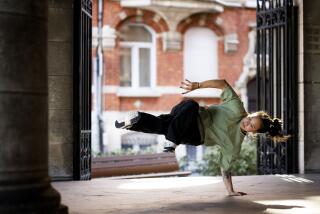Olympian May Be Able to Help Her Sport Net Some Attention : Badminton: Joy Kitzmiller has seen her specialty ignored by the public and by television. But guess who’s going to be carrying around a TV camera in Barcelona?
- Share via
Olympic badminton player Joy Kitzmiller doesn’t ask for much.
She can deal with the fact that badminton, in its first year as a medal sport, won’t be included in Olympic television coverage, not even on the three 24-hour pay-per-view channels. It would be a little easier to handle, though, if the channels weren’t showing synchronized swimming, rhythmic gymnastics and 12 hours of reruns daily.
And the Manhattan Beach native is aware that once badminton play begins Tuesday in Barcelona, she has “no chance” of winning a medal in the Asian-dominated sport. Although she is the reigning national champion in singles and doubles, Kitzmiller, 28, is ranked 98th in the world in singles and 35th in doubles. Of the top 12 players in the world, four are Chinese and two are Indonesian.
The only things Kitzmiller really wants are a little recognition and respect.
“I want to be recognized as a great athlete,” Kitzmiller said. “Not as some idiot who’s dedicated her whole life to nothing.”
The image badminton has is not a good one:
It’s a kid’s game. . . it’s something you only do in your back yard or at a picnic. . . it’s slow. . . who thought of this bird device that floats in the air. . . and if you like swinging a racket so much, why not just play tennis?
Badminton players don’t like it when you ask them, “Why not just play tennis?”
“It beats tennis all to heck,” said Ruth Kitzmiller, Joy’s mother and a player for more than 30 years. “The rallies are longer and there is no strain. You’re not carrying a heavy racket, hitting a hard ball. And you don’t have to chase the ball around. The bird is at your feet because you missed it.”
In fact, the indoor game hardly resembles the back yard model. The bird, or shuttlecock, is in constant motion and can be hit quite hard. With leaping, overhead smashes, top men players are able to send the bird flying at speeds as high as 120 m.p.h. And with the 20-foot width of the court, there is less chasing than hitting. A 1985 study showed that in a 78-minute match, the bird was in play 37 minutes. In a three-hour tennis match, the ball was in play 18 minutes.
“It’s just a much better game than tennis,” said Joy, who took tennis lessons once to prove what she knew almost since birth.
Ruth started playing badminton competitively when she and her husband moved to Manhattan Beach in 1959. Once neighbors heard that the couple had played the back-yard variety, they were urged to join the Manhattan Beach Badminton Club, one of only two existing indoor facilities in the Western United States (the other is at Arizona State University).
Joy was born into the sport, watching it as often as she watched cartoons. By age 8 she was taking free lessons at the club, and by 13 she was having a difficult time finding opponents.
“We loved the game and played all the time, and she passed us by,” said Ruth, who still plays four days a week. “I stopped playing her when she was 13.
“She got intense about it when she was 12 and went to one of her first tournaments. Our club went to the Junior Nationals in San Jose and she played three matches and lost all three. That was it. She hates to lose.”
When she was 14, Joy won the 14-and-under Pan American Games doubles title and reached the semifinals in singles. “That’s when I first realized I could do some things at the national level,” she said.
Not a naturally quick player, Joy relies on her reactions and a wide variety of shots (including a “fake,” where she pretends to hit it hard only to nudge it barely over the net). Add that her almost obsessive hatred of losing--”It’s a sense of relief when I win,” she said--and you have a three-time national champion in singles and doubles. After winning singles titles in 1987 and 1988, Kitzmiller won again on April 20, defeating defending champ Liz Aronsohn, 11-5, 7-11, 11-5. She has won the last three doubles titles, with two different partners: Ann French in 1990 and ’91 and Ann’s sister, Linda, this year.
But the fact her game is not good enough to compete for a medal hints at the strength of the Asian players. In China, children are singled out at ages 8 and 9 and tested for speed, reflexes and endurance. Four years later, the best athletes are sent to Beijing for intensive training.
“They are exposed to better players on a regular basis,” Kitzmiller said. “Our depth is not even close to that level.”
The gap in singles titles can be explained by a shift in passions: from badminton to math. A 1986 Stanford graduate with a degree in math, Kitzmiller taught full time at Garfield High until 1990. She plans a return to teaching eventually, depending on how deeply she is able to get involved in coaching badminton.
Kitzmiller may have stumbled upon a third possible career path when NBC selected her to be its video liaison. The network gave her a video camera and wants her to tape the daily experiences of an Olympic athlete.
“The press can’t come into the Olympic village where the athletes live,” she said. “And the general public wants to know how we live.
“Maybe badminton will get some coverage after all.”
More to Read
Go beyond the scoreboard
Get the latest on L.A.'s teams in the daily Sports Report newsletter.
You may occasionally receive promotional content from the Los Angeles Times.






